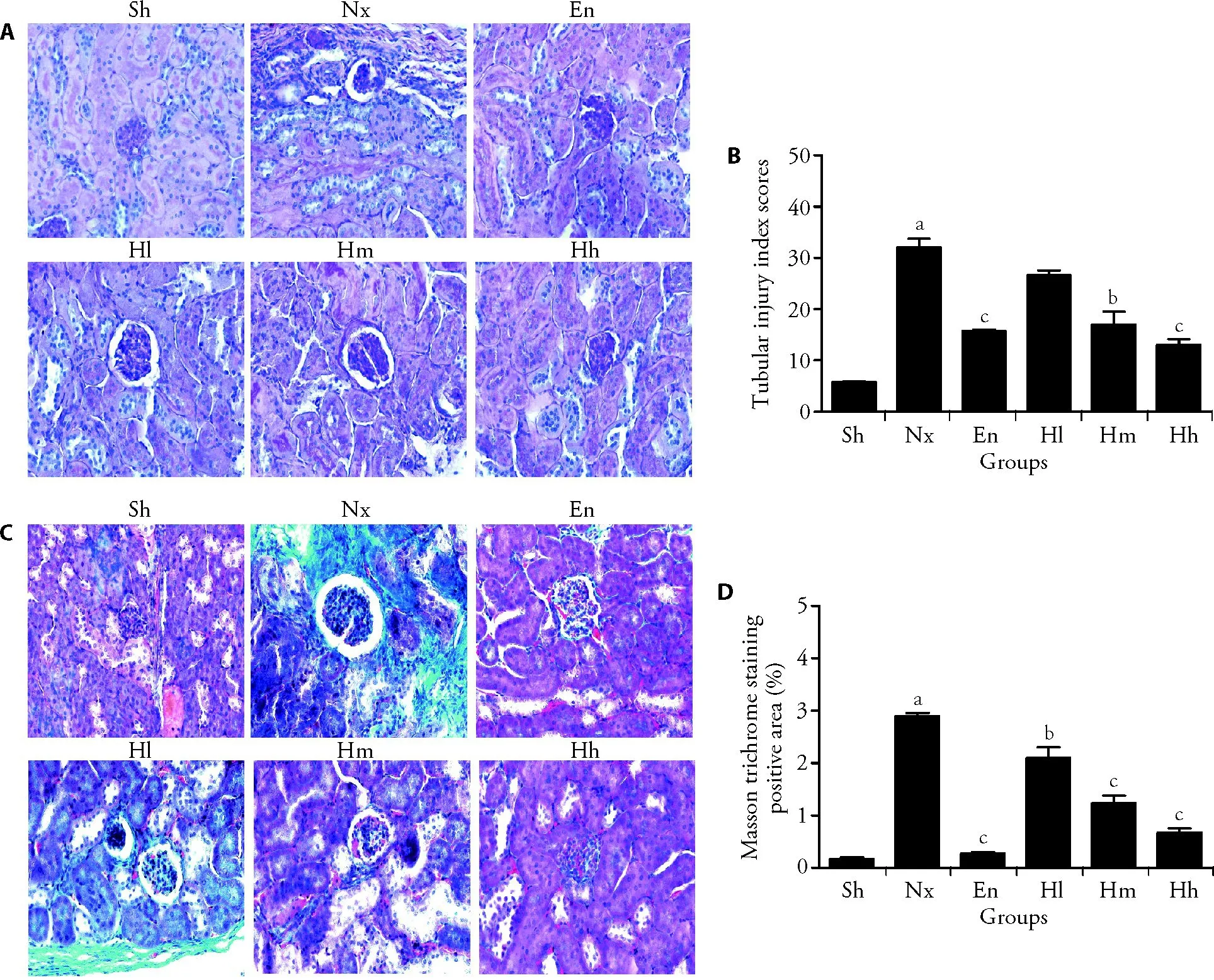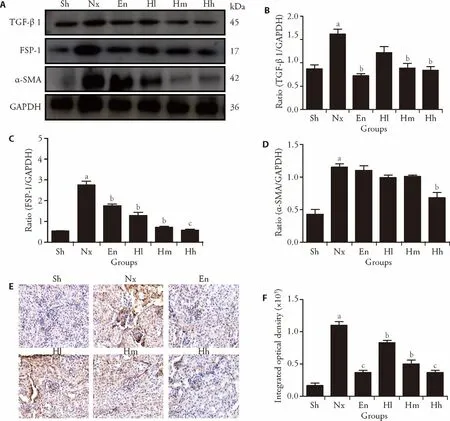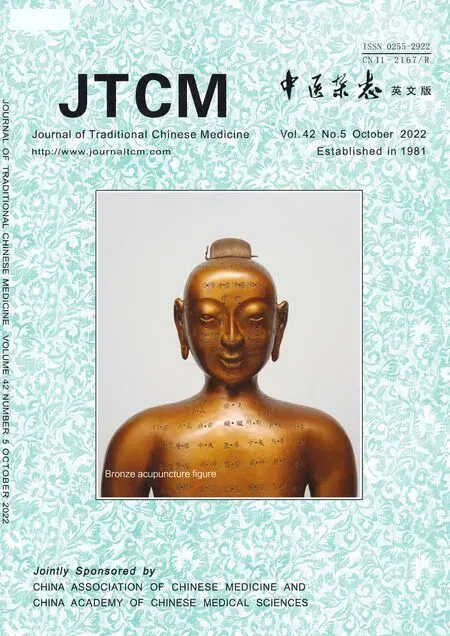Huangqi decoction (黄芪汤) attenuates renal interstitial fibrosis via transforming growth factor-β1/mitogen-activated protein kinase signaling pathways in 5/6 nephrectomy mice
ZHAO Jie,WANG Li,CAO Ai-li,WANG Yun-man,CHI Yang-feng,WANG Yi,WANG Hao,PENG Wen
ZHAO Jie,Department of Chinese Medicine/Department of Chinese Integrative Medicine,The First Affiliated Hospital,Anhui Medical University,Hefei 230022,China
WANG Yunman,CHI Yangfeng,WANG Yi,WANG Hao,PENG Wen,Department of Nephrology,Putuo Hospital affiliated to Shanghai University of Chinese Medicine,Shanghai 200062,China
ZHAO Jie,WANG Li,CAO Aili,WANG Hao,PENG Wen,Laboratory of Renal Disease,Putuo Hospital,Shanghai University of Chinese Medicine,Shanghai 200062,China
Abstract OBJECTIVE: To investigate the effect of Huangqi decoction (黄芪汤) on renal interstitial fibrosis and its association with the transforming growth factor-β1 (TGFβ1)/ mitogen-activated protein kinase (MAPK) signaling pathway.METHODS: 120 C57/BL mice were randomly divided into six groups: sham group,Enalapril (20 mg/kg) group,5/6 nephrectomy model group,and 5/6 nephrectomy model plus Huangqicoction (0.12,0.36 and 1.08 g/kg respectively) groups.Detecting 24hours urinary protein,blood pressure,serum creatinine,urea nitrogen content changes.Periodic Acid-Schiff stain (PAS) and Masson's trichrome staining was used to observe the renal tissue pathological changes.Protein expression of TGF-β1,Phosphorylated P38 mitogen activated protein kinases(P-P38),Phosphorylated c-jun N-terminal kinase (P-JNK),Phosphorylated extracellular regulated proteinhnase (PERK),Fibroblast-specific protein-1 (FSP-1),Alpha smooth muscle actin (α-SMA),Type III collagen(Collagen III),Connective tissue growth factor (CTGF),Bcl-2 Assaciated X protein (Bax) and B cell lymphoma 2(Bcl-2) were measured with western blot and immunohistochemical.RESULTS: Both Huangqi decoction and Enalapril improved the kidney function,24 h urinary protein and the fibrosis in 5/6 nephrectomy mice,Huangqi decoction downregulated the expressions of TGF-β1,FSP-1,α-SMA,Collagen III and CTGF in a dose-dependent manner,and it has a significant difference (P < 0.01)compared with model group.Huangqi decoction downregulated the expressions of P-P38,P-JNK,P-ERK and Bcl-2 in a dose-dependent manner,while upregulated the expression of Bax.CONCLUSIONS: The protective effect of Huangqi decoction for renal interstitial fibrosis in 5/6 nephrectomized mice via the inhibition of Epithelial-Mesenchymal Transitions and downregulating the TGFβ1/ MAPK signaling pathway.
Keywords: nephrectomy;transforming growth factor beta1;mitogen-activated protein kinases; Signal transduction;renal interstitial fibrosis;Huangqi decoction
1.INTRODUCTION
Chronic kidney disease(CKD) has posed a major global public health problem in recent years,1and tubuleinterstitial fibrosis was considered to be the final common pathway of this disease.2The p38 mitogenactivated protein kinase (MAPK) pathway is an intracellular signal transduction pathway involved in the production of proinflammatory and profibrotic mediators,and it is important in the pathogenesis of fibrosis with extracellular matrix synthesis.3Accumulating evidence shows that activation of MAPK has been demonstrated in fibrosis in various organs,and blockade of this pathway has been shown to inhibit transforming growth factor-β1 (TGF-β1) induced collagen expression in fibroblasts and mesangial cells.4-6Previously,Huangqi decotion has been demonstrated that could ameliorating tubulointerstitial fibrosisviaTGF-β1 Smad signaling pathway,7therefore the purpose of this study was to elucidate whether MAPK activity was involved in it.
2.MATERIALS AND METHODS
2.1.Drugs and reagents
All crudes of Huangqi decoction drugs were purchased from Shanghai Hua Yu Chinese Herbs Co.,Ltd.(Shanghai,China).The gradient of the decoction consisted Huangqi (Radix Astragali Mongolici),Fuling(Poria),Gualou (Fructus et Semen Trichosanthis),Maidong (Radix Ophiopogonis Japonici),Wuweizi(Fructus Schisandrae Chinensis),Gancao (Radix Glycyrrhizae),and Dihuang (Radix Rehmanniae).The solution of Huangqi decoction was analyzed by the LCMS/MS method.8Antibodies to TGF-β1,fibroblastspecific protein-1 (FSP-1),alpha smooth muscle actin (α-SMA),type I collagen (Collagen I),type III collagen(Collagen III),connective tissue growth factor (CTGF),B cell lymphoma 2 (Bcl-2) were purchased from Abcam(Cambridge,MA,USA);Bcl-2 Assaciated X protein(Bax) was purchased from R&D Systems (Minneapolis,MN,USA).
2.2.Animals and modeling
Animal experiments were approved by the ethics committee of Shanghai University of Traditional Chinese Medicine affiliated Putuo Hospital.A total of 120 male C57/BL mice [body weight (18 ± 2) g]purchased from Shanghai Sippr-BK experimental animal Co.,Ltd.(Shanghai,China) with specific pathogen freeclass breeding.After one week of adaptive feeding,mice were randomly divided into six groups: Sham group (Sh,n=20),Enalapri group (En,n=20),Nx group (Nx,n=20),High dosing of Huangqi decotion group (HH,1.08 g/kg,n=20),Medium dosing of Huangqi decotion group(Hm,0.36 g/kg,n=20),Low dosing of Huangqi decotion group (Hl,0.12 g/kg,n=20).The dosing of Huangqi decotion was adjusted according to body surface area of each mice,and drug was made with 0.5%sodium carboxymethyl cellulose into suspensions with con-centrations of 0.12,0.36 and 1.08 g/mL,respectively.Enalapril group were given enalapril with concentrations of 20 mg/kg.Each animal underwent a 5/6 Nx or sham operations (rats only) in two steps.Anesthesia was done by intraperitoneal injection of 3% sodium pentobarbital,an incision on the left side of the abdomen was made to expose and two-thirds of the mass of the left kidney was ablated,and a subsequent right unilateral Nx was performed 1 week later through a dorsolateral incision with decapsulation and ligation of the renal mass.The sham group only underwent laparotomy and exposure of the kidney.The control mammals did not undergo any operation.At 17 weeks after the last operation,blood samples and left kidney specimens were taken.
2.3.Blood pressure,24 h urinary protein,kidney index and renal function test
At 4 weeks after after completion of modeling,the blood pressure of caudal artery and the body weight were measured weekly and 24 h urinary protein were detected every 4 weeks.Kidney index means weight of the remanent renal/body weight.At 17 weeks after the last operation,serum was collectedby removalling eyeball after centrifugation to detect serum creatinine (Scr) and blood urea nitrogen (BUN),which were used to estimate renal function.Scr and BUN were determined by the creatinine colorimetricassay kit (BioVision,SF,USA)and BUN colorimetric detection kit (Arbor,Mi,USA)following the manufacturer’s protocol,respectively.
2.4.Histology and immunohistochemistry
The kidney tissue was fixed in 10% neutral formalin.After embedded in paraffin,sections were stained with hematoxylineosin staining and Masson trichrome staining.The assessment of tissue injury in the remanent kidney after PAS and Masson staining.Immunohistochemical detection was done using the ABC method,Collagen III (1: 100),CTGF (1: 200),α-SMA (1: 100)were added after rinsing with PBS (0.01 mol/L).The sheep anti-rabbit,goat anti-mouse secondary antibodies were then added.Image Pro Plus analysis software was used to calculate the mean optical density value.
2.5.Western blot analysis
Tissue protein samples (sample volume of 20 g) were separated by sodium dodecylsulphate polyacrylamide gel electrophoresis.After blocking with 5% BSA,anti-TGF-β1 (1:1000 dilution),FSP-1 (1:1000 dilution),TβRII (1:1000 dilution),Smad 2/3 (1:1000 dilution),p-Smad 2/3 (1:1000 dilution),P-JNK (1:1000 dilution),PERK (1:1000 dilution),α-SMA (1:1000 dilution),P-P38(1:1000 dilution),Bax (1:1000 dilution),Bcl-2 (1:1000 dilution),CTGF (1:000 dilution),GAPDH (1:1000 dilution),Collagen I/III (1:5000 dilution) antibodies were added and incubated overnight at 4 ℃.
2.6.Statistical Analysis
The GraphPad Prism 5.0 software (San Diego,CA,USA)was used for statistical analysis.Thettest was used to compare the difference between two individual groups,and one-way analysis of variance (ANOVA) was used to compare the difference among multiple groups;P <0.05 was considered statistically significant.
3.RESULTS
3.1.Effect of Huangqi decotion on blood pressure,body weight and kidney index
The blood pressure (Table 1) and the body weight showed no statistical significance among these groups in the first week (P >0.05).Till week 8,the blood pressure of mice in Nx group increased steadily.Till week 12,compared with Nx group,the weight gain in En group,Hm group and Hh group shows statistical difference (P<0.05) (Figure 1).One single kidney weight in Sham group was about(0.1567 ± 0.0076) g,the remanent kidney of Nx mice was about (0.1117 ± 0.0065) g.A statistical difference was found between the two groups.The remanent kidney of Hh group was about (0.1256 ± 0.0069) g.Compared with Nx group,the remanent kidney of Hh group was heavier,the difference between the two groups was statistically significant (P <0.001).The remanent kidney of Hm group and Hl group showed no difference statistically (P> 0.05).The Nx group,En group and Hm group showed no difference in the weight of remanent kidney (P>0.05) (Figure 1).

Figure 1 Effect of Huangqi decotion on weight,kidney index and blood pressure changes.
3.2.Effect of Huangqi decotion on 24 h urinary protein and renal function
As shown in Table 2,the 24 h urinary protein of mice insham group decreased after 4weeks,significantly higher than Nx mice (P <0.001).The trend was continued to week 8.At week 12,the 24 h urinary protein of Nx mice increased sharply.Till week 16,a statistical difference was found among Nx group and Nx+Hh group (P <0.05)(Table 2).

Table 1 Effect of Huangqi decotion on the blood pressure of the mice (mean,n=6)

Table 2 Effect of Huangqi decotion on 24 h urinary protein (s,n =6)
Determination of functional changes showed that serum creatinine (Scr) and blood urea nitrogen (BUN) levels significantly enhanced in Nx mice compared with Sh group,and attenuated in Nx animals treated with Huangqi decotion.The similar improvements on functional injuries were obtained by Nx animals treated with enalapril(Figure 2).
3.3.Huangqi decotion attenuates renal damage in a dosage-dependent manner in Nx mice
As shown in the figure,tubulointerstitial damage and inflammatory response were reduced in dose-dependent manner(P <0.01 or 0.001) in Nx remanent kidneys taken from Huangqi decotion treated mice compared with vehicle-treated Nx kidneys,which were demonstrated by semiquantitative histomorphometry analysis (Figure 3Ad,e,f).The same physiological changes were observed in En group (Figure 3Ac).This was also confirmed by semiquantitative assessment of the fibrotic area on the PAS-stained kidney sections (Figure 3B).5/6 nephrectomy model also induced an increase of collagen on the Masson’s trichrome-stained kidney sections compared with sham-operative kidneys (Figure 3C).However,treatment with Huangqi decotion in Nx kidneys led to less collagen deposition compared with vehicle treated Nx kidneys.This was also confirmed by semiquantitative assessment of the fibrotic area on the Masson’s trichrome-stained kidney sections (Figure 3D).
3.4.Huangqi decotion alleviates matrix accumulation in a dosage-dependent manner
In this study,we observed that the expression of Collagen III and CTGF by immunohistochemistry in Nx kidneys,and found that both of them were significantly higher than the basal expression levels in the Sham group(P <0.05).After Huangqi decoction in low-to-high concentrations were given,the expression of TGF-β1 and CTGF in the treatment group decreased dosedependently compared with those in Nx mice (P <0.05)(Figure 4).
The protein expression levels of TGF-β1,FSP-1 and α-SMA of Nx mice were observed.The Nx mice were significantly higher than the basal expression levels in the sham group (P <0.05).After Huangqi decoction in low-to-high concentrations were given,the protein expression of TGF-β1,FSP-1 and α-SMA in the treatment group decreased dose-dependently compared with those in the Nx group (P <0.05).The same physiological changes were observed in En group(Figure 5A-5D).Immunohistochemistry were adopted to detected the protein expression levels of FSP-1,andfound that the expression in Nx mice were significantly higher than Sh group (P <0.05).After Huangqi decoction in low-to-high concentrations were given,the protein expression of FSP-1 in the treatment group decreased dose-dependently (P <0.05) (Figure 5E).

Figure 2 Effect of Huangqi decotion on renal function.

Figure 3 Huangqi treatment attenuates renal damage in a dosage-dependent manner in Nx mice
3.5.Huangqi decoction could downregulate the MAPK signaling pathway in Nx mice
Western blot ofin vivoexperiments detected increased expression of P-P38,P-JNK,P-ERK in Nx mice.This expression decreased after Huangqi decoction treatment in a dose-dependently fashion.The same trend was observed in Bcl-2.Meanwhile,the expression of Bax protein significantly decreased in Nx model,and no difference after Huangqi decoction were given (Figure 6).

Figure 4 Huangqi decoction decreases the Nx kidneys’ CTGF and Collagen III expression by immunohistochemistry

Figure 5 Huangqi decotion alleviates matrix accumulation in Nx kidneys

Figure 6 Huangqi decotion downregulats MAPK signaling pathway on kidney sections
4.DISCUSSION
There was no such renal interstitial fibrosis term in Traditional Chinese Medicine (TCM),but it could be attributed to Shenfeng from its clinical manifestations and symptom characteristics.Discrimination of viscera and blood,and asthenicYinandYangwere the precondition and pathogenesis,turbidity toxin stagnated kidney collateral were extrinsic triggers.Since treating disease from the root is the principle of TCM,“tonifying the spleen and the kidney”is the indispensable parts of the ancient Chinese physicians for the treatment of renal interstitial fibrosis,and Huangqi decoction is one of the most classic recipes in the clinical treatment of chronic kidney disease.Huangqi decoction was first recorded inYang shiying's Renzhai Zhizhi Fang Volume 17 dating back to Northern Song Dynasty.Over the past years modern pharmacological studies have made considerable progress and proved to be helpful in fibrosis disease of each single drug in Huangqi decoction.For instance,astragalus and its representative active saponin compound could alleviate renal interstitial fibrosis by downregulating TGF-β/Smad and Wnt/β-Catenin signaling pathway.9-11Poricoic acid ZA,a novel RAS inhibitor attracted from Wolfiporia extensa,attenuates tubulointerstitial fibrosis and podocyte injury by inhibiting TGF-β/Smad signaling pathway.12Shizandra had been used to ameliorate the DN in the C57BL/6 mice,and its mechanism may relate to inhibition on the epi-thelial to mesenchymal transdifferentiation,endothelial-myo-fibroblast transition and PAL-1 expression.13The study has been indicated that Dihuang (Radix rehmanniae) can improve the renal function and inhibit renal fibrosis of DN ratviamodulating RAS system.14
Renal interstitial fibrosis is the common way and underlying mechanisms to final renal failure for most of the progressive,15various kinds of molecules and different signaling pathways were involved in this course.16-18It is far more than traditional simple scar,but rather as a dynamic unbalance of extracellular matrix components(EMC) of renal cell system.19Variability and phenotypic modulation may be the basic two characteristic for these cells.20,21Similar to wound healing,renal fibrosis originates from protective reaction to the damage,but ends with glomerular sclerosis,tubular atrophy and.22,23Among all the relavent factors,renal tubulointerstitial fibrosis plays more dangerous role than others and has close relationship with End-Stage Renal Disease.24Epithelial-mesenchymal transition (EMT),a process whereby fully differentiated epithelial cells undergo transition to mesenchymal phenotype,have been demonstrated that a key step in tubulointerstitial fibrosis.3,25EMT causes a substantial increase in the number of myofibroblasts that contributes to the development of progressiverenal fibrosis.26,27Activated fibroblasts may undergo functional and phenotypic changes and transform into myofibroblasts expressing smooth muscle actins (SMAs) and fibroblast-specific protein1 (FSP-1).28The ability of the myofibroblasts in ECM synthesis would be markedly enhanced and thus continuous accumulation of interstitial matrix would ensue.29,30In the study,we detected the expression of FSP-1 and α-SMA by Western Blot and found that both of them increased significantly in Nx mice.After given Huangqi decotion,the expression of FSP-1 and α-SMA decreased dose-depently.The expression characteristics of FSP-1 had been further validated in immune-histochemical.The same trend was observed in Collagen III.Therefore,we may cautiously concluded that Huangqi decoction could alleviate EMT and extracellular matrix accumulation by inhibiting Collagen III protein expression in a certain extent,and thereby improve renal interstitial fibrosis.
TGF-β1 is the major pro-fibrotic cytokine known to participate in the progression of fibrosis.31Except the Smad signalling pathway,no-canonical pathway also involved in TGF-β1 induced tubular EMT and the best characterized being JNK and p38MAPK.32It controls TGF-β induced tubular EMT by increasing the expression of collagen and α-SMA.The mammalian MAPK family comprises p38,c-Jun NH2-terminal kinases,and extracellular signal-regulated kinase (ERK),each of which is involved in the pathogenesis of many human diseases.33In this study,we found increased expression of P-P38,P-JNK,P-ERK in Nx models and could be decreased by Huangqi decotion in a dosedependently fashion.It is likely that inhibition of TGFβ1/ MAPK pathway,may be the potential mechanisms of Huangqi decotion to protect kidney from fibrosis.It is reported that MAPK signaling pathway exerts important effects on renal tubular epithelial cell apoptosis induced by renal injury34.Conversely,when the anti-apoptotic protein Bcl-2 is overexpressed,it can inhibit apoptosis by directly binding to Bax and inhibiting Bax activation.35Therefore,the expression relation of the ratio between Bcl-2 and Bax is the key to decide the survival of cells.36The results suggested that the Bcl-2 expression decreased after Huangqi decoction treatment in a dose-dependently fashion.The Bax showed the opposite trend.These results presented that Huangqi decotion can reduce renal interstitial fibrosis via inhibition of apoptosis at the early stage.
In summary,the present results support that activation of TGF-β1/MAPK pathway contributes to EMT,as well as to fibrosis,cell proliferation and apoptosis,whereas Huangqi decotion could relieve renal interstitial fibrosis of Nx mice by down regulating it.In addition,Huangqi decotion can be a novel therapeutic drug in ameliorating the progression of Chronic kidney disease.
 Journal of Traditional Chinese Medicine2022年5期
Journal of Traditional Chinese Medicine2022年5期
- Journal of Traditional Chinese Medicine的其它文章
- Shugan Jieyu capsule (舒肝解郁胶囊) improve sleep and emotional disorder in coronavirus disease 2019 convalescence patients: a randomized,double-blind,placebo-controlled trial
- Application value of Qisexingtai hand diagnostic method in diagnosis of coronary artery disease
- An infrared thermographic analysis of the sensitization acupoints of women with primary dysmenorrhea
- Preliminary single-arm study of brain effects during transcutaneous auricular vagus nerve stimulation treatment of recurrent depression by resting-state functional magnetic resonance imaging
- Effect of treatment with Fufang Huangqi decoction (复方黄杞汤剂)on dose reductions and discontinuation of pyridostigmine bromide tablets,prednisone,and tacrolimus in patients with type I or II myasthenia gravis
- Wenshen Jianpi recipe (温肾健脾方) induced immune reconstruction and redistribution of natural killer cell subsets in immunological nonresponders of human immunodeficiency virus/acquired immune deficiency syndrome: a randomized controlled trial
